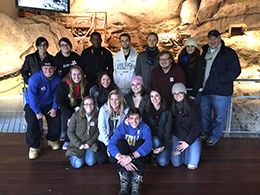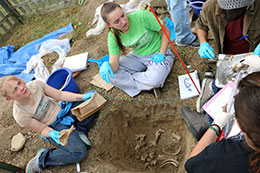Anthropology program gives students hands-on opportunities to apply what they learn
The anthropology program at Indiana University East is providing students with new hands-on opportunities to enhance their educational experience.
This semester, students have traveled to West Virginia and Pennsylvania to visit historic sites including Grave Creek Mound Archaeological Park and Meadowcroft Rockshelter. In the classroom, students now have access to bone casts of human and animal species to study. Through the forensics course, a pig skeleton was buried on campus so that students could practice excavation and document findings.
Katherine Miller, assistant professor of anthropology, said when she joined the faculty in fall 2014, she wanted to expand the program, including the addition of the forensics course that is being taught this fall for the first time.
Through the course, students were provided with an opportunity to do what archaeologists and forensic scientists get to do in the field.
Miller found a farmer in Martinsville, Ind., who was willing to donate a pig to the forensics course. Miller said the after the 6 month-old, 250 pound hog passed away from natural causes, she retrieved the hog’s skeleton. Miller dug four holes on campus with the help of Marc Wolf, adjunct professor of anthropology and geography; Eevett Loshek, lecturer in psychology; and Amanda Kraha, assistant professor in psychology. The students then excavated, studied, identified and cataloged the bones and dig site.
Seth Winstead is in the forensics course. Winstead, of Connersville, Ind., is a sociology major with an anthropology focus and he is also working on minors in history and psychology. He said he enjoyed the process of excavating the pig.
“I liked being able to take what we were learning and apply it. We were able to actually do and see the methods we read about and get a feel for what forensic anthropology and archaeology entails. I would have to say my favorite part was doing the mapping and grids,” Winstead said.
To help students learn how to identify different bones in the field – and different species – the IU East Schools of Humanities and Social Sciences and the School of Natural Science and Mathematics purchased osteological materials. The casts of human and animal bones include various fractures, bullet wounds, a Native American skull, a soldier’s humerus from the Civil War, a chimpanzee’s pelvis, skulls from males and females of various ancestral backgrounds, fragments of a foot, sternum, face, and other bones to help students practice identifying different bones. The casts help students to understand the variety they could see through osteology forensics, Miller said.
Outside of the classroom, students had an opportunity to travel to Grave Creek Mound Archaeological Park and Meadowcroft Rockshelter as an extracurricular activity this fall. Ten students traveled to the sites October 3-4. Students who participated were from a diverse background in disciplines including majoring in criminal justice, nursing, education, sociology, anthropology, psychology and fine arts.
Miller and Wolf drove two vans loaded with students to West Virginia to the sites. The first stop was in Moundsville to the Grave Creek Mound Archaeological Park, one of the largest burial mounds in North America at over 60 feet tall dating to 250-150 B.C. While at Grave Creek, students were given a behind-the-scenes tour of the collections area, research laboratory and conservation facility as part of the Archaeology Days event going on that day. Students saw flint knapping, pottery making, and had a friendly, impromptu competition in atlatl throwing (throwing a hunting spear).
“The cool thing about the collections area is that all the material in West Virginia gets housed in this facility. So they got to go to a real archaeological working lab and to see what archaeological storage looks like – the stuff that needs to be cleaned, that has been cleaned and what has been conserved,” Miller said.
Miller said the site was once occupied by the Adena people who lived in the area from 1,000 B.C. to about A.D. 1. The Adena were one of the earliest and first groups of people to settle in the area. The Adena lived across North America in the modern states of Ohio, Indiana, West Virginia, Kentucky, Pennsylvania, and New York.
“Aside from the large earthen construction of the Adena people built around 150-250 B.C., a well explained tour and informative exhibits in the park’s museum awaited the IU East contingent as well. The students participated in events, saw demonstrations of the production of stone-tools, traditional clothing, and observed the layout of an important Paleo-Indian North American settlement,” Wolf said.
Later in the day, the group traveled to Meadowcroft Rockshelter, located in Avella, Pa. The site dates to as early as 19,000-16,000 years ago and represents a site of some of the first people to live in North America. The site is believed to be where the first people lived after crossing the Bering Land Bridge and much of North America to settle in the region. This site has the longest occupation history of any site in the New World.

Students traveled to Meadowcroft Rockshelter to learn about archaeology and early cultures and lives of some of the first people to live in North America.
At this site, students studied stone tools and artifacts, visited a wigwam, and learned about farming and the gardening system that used a rotation of corn, beans and squash. They also visited a reconstructed colonial 19th century village and a 16th century Monongahela Native American village to see what life was like during these time periods.
Wolf said the trip provided students with time to talk about many topics from politics and government to discussing the Paleo-Era native Americans culture and what they would find at the sites. “Every comment and musing was also framed by the perennial question of where individual sites and peoples and times fit into a larger view of the New World,” Wolf said.
The School of Humanities and Social Sciences funded the trip and students paid a small fee for meals and the overnight stay.
Winstead was one of the students on the trip. He said the trip was informative and allowed the students to meet people from different campuses. One of the students to attend is from IU Northwest and is in an online course at IU East.
“It was very neat to get to see sites where people had lived thousands of years ago, as well as the evidence they had left behind. For Grave Creek in particular, it was interesting to note that the town was sort of centered around the burial mound, they did not seem to disturb it. Overall, the trip was very informative and allowed for us to meet different people from different campuses,” Winstead said.


